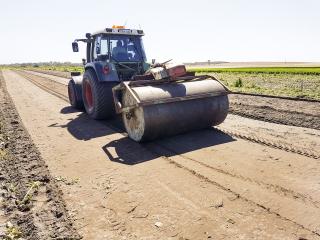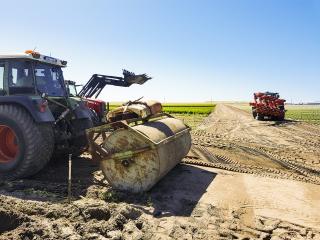Promising research is pointing to a quick, low cost, non-chemical solution to control the serious declared pest stable fly, which could improve business profitability at the same time.
The Department of Agriculture and Food project, co-funded by Horticulture Innovation Australia, has found burying vegetable crop waste after harvest and then compacting the soil surface can significantly reduce stable fly populations.
Department research officer David Cook said the practice could provide vegetable growers with an effective option to control stable flies in situ, reducing the use of pesticides.
“Our work has found that by burying post-harvest vegetable crop residues to a depth of 300 millimetres with a stone burier or a mouldboard plough and then compacting the sand lightly with a roller, makes it almost impossible for the stable fly to dig its way to the surface and emerge as an adult fly,” Dr Cook said.
“The newly developed adult has not developed a hard exoskeleton or wings at his stage, so it simply doesn’t have the strength to penetrate the compacted sand, which dries to form a hard crust.
“The process effectively prevents the flies from breeding and emerging from the soil.”
Initial research results have been very encouraging and, while it does not eliminate stable flies altogether, trials have shown that compaction can reduce stable fly numbers by as much as 95 to 99 per cent.
Dr Cook said the soil inversion practice also enabled the land to be cultivated more frequently, while also addressing other production constraints.
“Once the soil has been inverted, growers can go back in and immediately sow another crop, without worrying about the risk of stable flies, making the land more productive and profitable,” he said.
“It could also help to reduce soil erosion, which can be a major problem on sandy soils, which are prominent in the Western Australian vegetable production areas.”
The research has built on laboratory trials in the past year and field trials recently commenced on large vegetable production areas principally around Gingin to test the practice with the commercial sector.
The trials will assess the effectiveness of various soil and waste burying and compaction machinery combinations to determine the optimal process during the next 12 months.
Current best management practice for handling post-harvest vegetable crop residues involves high speed mulching, turning off overhead irrigation and treating it with a pesticide.
“This process can reduce stable fly populations from as high as 1000 per square meter when left totally untreated to as few as 20-50 flies per square metre,” Dr Cook said.
“Our expectation is that by simply deep burying and compacting the sandy soils, there will be less need to use a pesticide to control stable flies, reducing the steps to handle post-harvest residues to just two, along with control costs.”
The research has already drawn interest from overseas, including United States producers, Costa Rican pineapple growers and Brazilian sugar cane growers.
Stable flies have been a particular problem in rural and semi-rural areas near the Perth metropolitan area this year, due to record summer rainfall.
The department and affected shires undertake regular inspections to ensure vegetable waste is disposed of in a suitable way so as to minimise the risk of stable fly breeding.
Development officer Don Telfer said the community also played a key role in reducing the stable fly population.
“It is important for small landholders and livestock owners to curtail potential stable fly breeding environments by removing waste feedstuffs, poorly made compost, piled lawn clippings and unused vegetable feed in a suitable way,” Mr Telfer said.
“The department suggests heaping excess hay or vegetable matter and spraying it with an insecticide, before covering it with black plastic for at least a month to eradicate the flies and larvae.
“Ideally, all vegetable matter fed to livestock should be in troughs, where contact with the soil is minimised.”
Any sightings of stable fly can be reported to the department via its free MyPestGuide Reporter app.
For more information about stable flies in Western Australia click here.


Media contacts: Jodie Thomson/Megan Broad, media liaison
+61 (0)8 9368 3937
